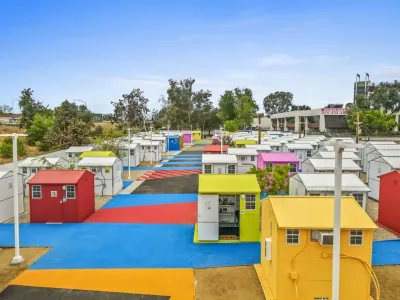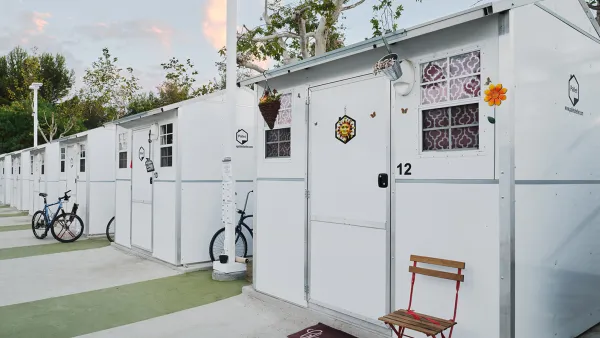Cities are trying to stretch affordable housing funds to meet the demand for both short- and long-term housing.

An article by Jeanne Kuang in CALmatters argues that, despite concerns about their effectiveness, ‘tiny homes’ are likely to remain an important part of California’s efforts to eliminate homelessness.
‘Tiny home villages,’ as the projects are known, “aim to fill the steps between traditional, congregate homeless shelters — think ‘room full of bunk beds and cubicles’ — and an apartment of one’s own.”
Also known as modular homes or ‘emergency interim housing,’ these prefabricated structures can offer a stepping stone to long-term housing. San Jose city officials say the city’s unsheltered population has declined by 10 percent after the city opened six tiny home sites, and “of the 1,500 people the city has sheltered in its tiny home sites, 48% moved to permanent housing.”
While tiny home villages may offer a lifesaving stopgap, advocates warn that ending homelessness will require a larger effort to address the root causes of high housing costs and the lack of affordable housing. The article notes other conflicts arising as tiny homes become a more permanent fixture, such as their legal status and whether tenants should be charged rent.
FULL STORY: Why tiny homes will remain part of California’s homelessness equation for years

National Parks Layoffs Will Cause Communities to Lose Billions
Thousands of essential park workers were laid off this week, just before the busy spring break season.

Retro-silient?: America’s First “Eco-burb,” The Woodlands Turns 50
A master-planned community north of Houston offers lessons on green infrastructure and resilient design, but falls short of its founder’s lofty affordability and walkability goals.

Delivering for America Plan Will Downgrade Mail Service in at Least 49.5 Percent of Zip Codes
Republican and Democrat lawmakers criticize the plan for its disproportionate negative impact on rural communities.

Test News Post 1
This is a summary

Test News Headline 46
Test for the image on the front page.

Balancing Bombs and Butterflies: How the National Guard Protects a Rare Species
The National Guard at Fort Indiantown Gap uses GIS technology and land management strategies to balance military training with conservation efforts, ensuring the survival of the rare eastern regal fritillary butterfly.
Urban Design for Planners 1: Software Tools
This six-course series explores essential urban design concepts using open source software and equips planners with the tools they need to participate fully in the urban design process.
Planning for Universal Design
Learn the tools for implementing Universal Design in planning regulations.
EMC Planning Group, Inc.
Planetizen
Planetizen
Mpact (formerly Rail~Volution)
Great Falls Development Authority, Inc.
HUDs Office of Policy Development and Research
NYU Wagner Graduate School of Public Service





























